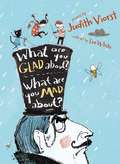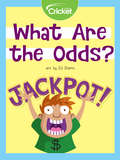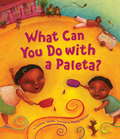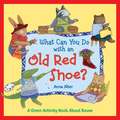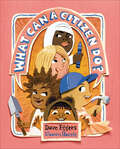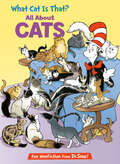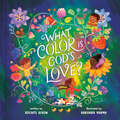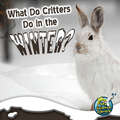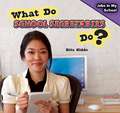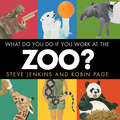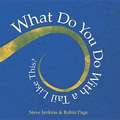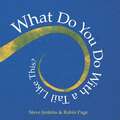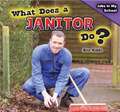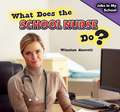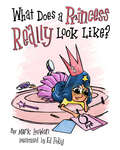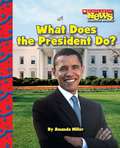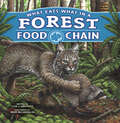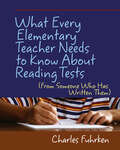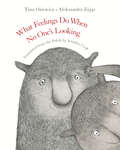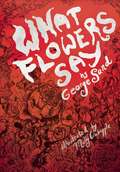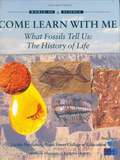- Table View
- List View
What Are You Glad About What Are You Mad About: Poems for When a Person Needs a Poem,
by Judith ViorstFrom school to family to friends, from Grrrr to Hooray!, Judith Viorst takes us on a tour of feelings of all kinds in this thoughtful, funny, and charming collection of poetry that's perfect for young readers just learning to sort out their own emotions.
What Are the Odds?
by Liz HuyckProbability and odds are calculated by counting all the times something might happen and then how many times one particular outcome does happen.
What Can You Do with a Paleta?
by Carmen Tafolla Magaly MoralesWhere the paleta wagon rings its tinkly belland carries a treasure of icy paletasin every color of the sarape . . .As she strolls through her barrio, a young girl introduces readers to the frozen, fruit-flavored treat that thrills Mexican and Mexican-American children. Create a masterpiece, make tough choices (strawberry or coconut?), or cool off on a warm summer's day--there's so much to do with a paleta.
What Can You Do with an Old Red Shoe?: A Green Activity Book About Reuse
by Anna AlterWhat can Ruby do with her old red show? Use it as a planter for pansies! In this "green" craft book, children can appreciate that recycling is a part of everyday life, and with a little creativity, exciting projects are only a few steps away. Turn a worn flip-flop into an art stamp, a ripped shower curtain into an apron, and an old T-shirt into a pillow. These activities are just a few of the many crafts to be explored. With easy-to-follow instructions, this interactive book will challenge kids to come up with clever recycling ideas of their own in no time!
What Can You Do?
by Linda Lott Ginger NielsonThe fun and excitement of English and Language Arts learning continues in Grade 2 of Reading Street. This comprehensive and dynamic curriculum for homeschooling is geared toward young children who have some foundational English and Language Arts knowledge and are ready to strengthen their skills. Comprised of engaging activities, challenging content and weekly quizzes, Reading Street: Grade 2 is the next step in your child's path toward becoming a lifelong learner and reader. As with all Reading Street products, the Grade 2 system is formatted to help students meet certain age-appropriate goals. After completing this English and Language Arts homeschool program, your child should be able to: Read and comprehend two-syllable words. Identify common prefixes (such as pre-, un-, or re-) and suffixes (such as -able, -ad and -er). Correct mistakes made when reading out loud. Read books with two or more chapters. Understand the structure of stores (i. e. beginning, middle and end). Start selecting reading materials based on his/her own interests. Identify the "who," "what," "when," "where," "why" and "how" of the text. While the goals of second Grade English and Language Arts are numerous, Reading Street will help you craft engrossing lessons. Your child will garner important English and Language Arts skills while completing a workbook, reading stories and poems, and taking assessments. Planning these lessons will be easier than ever, as all Reading Street systems are broken down into weekly Big Ideas. All the work your child does on a given week is formulated around that single concept for an organized and challenging curriculum. With six easy-to-follow units, Reading Street: Grade 2 is the perfect tool for homeschooling parents. Your child will enjoy the reading selections and activities, and you'll love to see your student growing into a knowledgeable individual. We're confident that this product is the right one for you. For more information on the specific materials found in Grade 2 of Reading Street, check out the Features and Benefits page.
What Can a Citizen Do?
by Dave Eggers Shawn Harris&“[This] charming book provides examples and sends the message that citizens aren&’t born but are made.&” —The Washington Post This is a book about what citizenship—good citizenship—means: Across the course of several seemingly unrelated but ultimately connected actions by different children, we watch how kids turn a lonely island into a community—and watch a journey to what the world could be. With beautiful illustrations and rhyming text, What Can a Citizen Do? is the latest collaboration from the team behind Her Right Foot: New York Times–bestselling author Dave Eggers and acclaimed artist Shawn Harris. It&’s a delightfully engaging way for young readers to be inspired about the meaning of citizenship and the positive role they can play in our country and our world. &“Obligatory reading for future informed citizens.&” —The New York Times &“An absolute delight.&” —Maile Meloy, New York Times–bestselling author of Do Not Become Alarmed &“[A] must-have book.&” —School Library Journal
What Cat Is That? All About Cats: All About Cats (The Cat in the Hat's Learning Library)
by Tish RabeLaugh and learn with fun facts about cats, from domestic to wild, kittens to cubs, and more—all told in Dr. Seuss&’s beloved rhyming style and starring the Cat in the Hat! &“I&’m the Cat in the Hat. Let us leave right away to see all the cats we can see in one day.&” The Cat in the Hat&’s Learning Library series combines beloved characters, engaging rhymes, and Seussian illustrations to introduce children to non-fiction topics from the real world! Travel aboard the Kitty-Cat-Copter and learn: • how cats fit through small spaces• how they use their whiskers• why their eyes glow in the dark• and much more! Perfect for story time and for the youngest readers, What Cat Is That? All About Cats also includes an index, glossary, and suggestions for further learning. Look for more books in the Cat in the Hat&’s Learning Library series!If I Ran the Horse Show: All About HorsesClam-I-Am! All About the BeachMiles and Miles of Reptiles: All About ReptilesA Whale of a Tale! All About Porpoises, Dolphins, and WhalesSafari, So Good! All About African WildlifeThere's a Map on My Lap! All About MapsOh, the Lavas That Flow! All About VolcanoesOut of Sight Till Tonight! All About Nocturnal AnimalsOnce upon a Mastodon: All About Prehistoric MammalsOh Say Can You Say What's the Weather Today? All About WeatherThe Cat on the Mat: All About Mindfulness
What Color Is God's Love?
by Xochitl DixonThis playful rhyming picture book invites young readers to discover all the ways God&’s love can be displayed through a rainbow of colors.All the colors displayed in this world that God made—every glorious, fabulous, beautiful shade—show how good God is and will always be.But what is the color of love? Come and see!God created all the colors in the world, and in each one, we can discover how great His love is for us and how we can let that love shine to others! With each turn of the page, the focus shifts to a specific color—orange, yellow, blue, green, pink, black, white, gray, brown, red, purple—and explores a different attribute and expression of love through its many shades.
What Do Critters Do In The Winter? (My Science Library)
by Julie LundgrenIntroduce your child to different types of animals and how they hibernate, camouflage, and migrate during the cold with the children’s book What Do Critters Do in the Winter?How do different animals survive the winter season? Learn about the different behavioral patterns of critters during the cold months.Fun Storybook Features:This children’s book features a glossary, an index, and post-reading questions to develop comprehension skills.24 pages of vivid photographsLexile 650LAbout Rourke Educational MediaWe proudly publish respectful and relevant non-fiction and fiction titles that represent our diverse readers, and are designed to support reading on a level that has no limits!
What Do School Secretaries Do? (Jobs in My School Ser.)
by Rita KiddeSchool secretaries are organized, friendly, and dedicated, but many young students don't give them much thought. By reading more about school secretaries, students will come to better understand and appreciate the many ways these individuals ensure that their schools run smoothly.
What Do You Do If You Work at the Zoo?
by Steve Jenkins Robin PageFrom Caldecott Honor–winning team Steve Jenkins and Robin Page comes an early introduction to one of young readers&’ favorite places: the zoo! Going to the zoo is so exciting! You might see penguins swimming underwater, snakes sunning in the reptile house, or giraffes eating leaves out of high trees. You might even see people at the zoo, ones just like you! But what do those people do? Caldecott Honor–winning team Steve Jenkins and Robin Page introduce young readers to the people who keep zoo animals safe, healthy, and happy, even though they aren&’t in the wild habitats they&’ve evolved for. From cuddling a baby kangaroo to trimming elephant toenails to playing soccer with a rhino, zookeepers work hard and do some pretty wacky things to take care of the incredible animals we see. So, what would you do if you were in the zookeeper&’s shoes? Turn the page and find out!
What Do You Do With a Tail Like This?
by Steve JenkinsA nose for digging? Ears for seeing? Eyes that squirt blood? Explore the many amazing things animals can do with their ears, eyes, mouths, noses, feet, and tails in this beautifully illustrated interactive guessing book by Steve Jenkins and Robin Page.<P><P> <b>Winner of the Caldecott Honor</b>
What Do You Do with a Tail Like This? (Journeys 2014)
by Steve Jenkins Robin PageA nose for digging? Ears for seeing? Eyes that squirt blood? Explore the many amazing things animals can do with their ears, eyes, mouths, noses, feet, and tails in this interactive guessing book, beautifully illustrated in cut-paper collage, which was awarded a Caldecott Honor.This title has been selected as a Common Core Text Exemplar (Grades K-1, Read Aloud Informational Text).
What Does A Janitor Do? (Jobs in My School)
by Rita KiddeJanitors do much more than just sweep and mop the floors. They are also responsible for making sure everything in the school is in proper working order. <p><p>By using simple language and illustrative photography, this book is designed to help students understand just how big and important a janitor’s job is.
What Does The School Nurse Do? (Jobs in My School Ser.)
by Winston GarrettFrom treating stomachaches to cuts or even worse, the school nurse makes sure students remain well, safe, and happy. Early readers will take a closer look at this vital job, and, in doing so, overcome any anxiety that may have when visiting the school nurse.
What Does a Princess Really Look Like?: Companion To What Does A Princess Really Look Like? (Brave Like A Girl Ser. #1)
by Mark Loewen Ed PokojWhat Does the President Do? (Scholastic News Nonfiction Readers)
by Amanda MillerThe book takes a look at the things that the Presidents do as part of their job, where they work from, and what they do when they are not working.
What Eats What in a Forest Food Chain (Food Chains Ser.)
by Lisa J. AmstutzA temperate deciduous forest teems with life. From a tall oak tree to a turkey vulture, the living things in this books are linked together in a food chain. Each one of them needs the others in order to live. Find out what eats what in a forest!
What Every Elementary Teacher Needs to Know About Reading Tests: (From Someone Who Has Written Them)
by Charles FuhrkenWhen he was a student struggling to concentrate on dreadfully boring passages of standardized reading tests, Charles Fuhrken remembers thinking to himself, 'Who writes this stuff?' He had no idea that one day it would be him. ' Fuhrken has spent years working as a writer for several major testing companies, and he believes that what he's learned about testing could be very usefuleven liberatingfor teachers interested in teaching effective reading strategies as well as preparing students for reading tests. In What Every Elementary Teacher Needs to Know About Reading Tests (From Someone Who Has Written Them), Fuhrken' takes the mystery out of reading tests. He explains how reading tests are created, how standards are interpreted and assessed, and how students can apply their knowledge of reading to standardized tests.' ' What Every Elementary Teacher Needs to Know About Reading Tests sets the record straight about the myths and realities of tests and offers extensive, practical strategies that help students perform well on test day. This ready to use, easy to understand resource provides a wealth of information about reading tests, including high-quality preparation materials; samples of the most frequently assessed reading standards; and more than thirty engaging, core-reading activities. ' Tests require a special kind of savvy, a kind of critical thinking and knowledge-application that is not always a part of classroom reading experiences. That's why teachers need to provide students with sound, specific information about reading tests. Only then can students feel prepared and confident on test day. '
What Feelings Do When No One’s Looking
by Tina OziewiczAn unruly cast of emotions come alive in this romping dreamworld, a place Maurice Sendak&’s Wild Things could call homeCuriosity, a lithe and floppy-eared creature, perches above the open world and gazes out with a zippy blend of hope, wonder, and longing. From the tip of a chimney, we bound into the quiet and mischievous world of feelings, meeting a troupe of tufted creatures as we go. Sympathy helps snails cross a sidewalk to safety, fear pirouettes in an attempt to camouflage with wallflowers, and pleasure reclines across a doily-donned reading chair, sipping a cup of tea. Elsewhere, our insecurities – pesky, cavorting beings – build intricate cages and stride about with clattering sets of keys. Tina Oziewicz&’s words hum with truth, and Aleksandra Zajac&’s illustrations bloom and burst with charming details like a sail constructed out of a pair of billowing long johns or a red slipper falling from a contented paw. Taking in the perfect harmony of this book is like taking a long gulp from a trusty thermos and filling up with warmth. What Feelings Do When No One&’s Looking surprises and soothes, inspires us to feel.
What Flowers Say
by George Sand Molly Crabapple Holly Erskine HirkoRoses plead to go out to dance; an old oak tree offers advice; paintings of gods and goddesses come alive. In What Flowers Say, renowned writer George Sand dares children to fantasize, to believe in an alternate world. This magical collection, originally penned for her grandchildren, calls into question what is real, a life lesson from someone who refused to accept the gender roles available to women in the nineteenth century. Sand shares her love and immense knowledge of science and mythology, engages issues of class and character, and captures the wonder and determination of a curious child, offering all of us a true sense of infinite possibilities--well beyond the world we live in.George Sand (1804-76) is considered the first professional woman writer of fiction. She wrote many novels, including Indiana and Léila, plays, newspaper articles, and a memoir, Story of My Life. The movie Impromptu is based on her life.Molly Crabapple is a painter, illustrator, and writer based in New York. She has written many books, including Discordia and Week in Hell, and produced work on subjects including the Spanish general strike, her former career as a pinup model, her arrest during Occupy Wall Street, and her visit to Guantanamo Bay. Her illustrated memoir, Drawing Blood, is forthcoming in 2015.
What Fossils Tell Us: The History of Life (Come Learn With Me Series)
by Bridget AndersonThis book examines the ever-unfolding stories these fossils reveal about life on Earth. Dig in and learn how fossils were formed, and find out about some of the important people and places in the field of paleontology (the study of fossils and ancient life).
What Happens to Our Trash? (Let's-Read-and-Find-Out Science 2)
by D. J. WardRead and find out about how we can reduce, reuse, and recycle in this colorfully illustrated nonfiction picture book."Perfect for classes just beginning to study environmental concerns," wrote School Library Journal. "Engaging prose and upbeat, gently humorous illustrations introduce the importance of proper trash disposal and recycling."This is a clear and appealing science book for early elementary age kids, both at home and in the classroom. In clear language and art, including diagrams, the book takes readers through such details as how much trash each person creates every day (on average), where the trash goes, and ways kids can make a difference. It concludes with instructions on how to create a compost pileWhat Happens to Our Trash is a Level 2 Let's-Read-and-Find-Out, which means the book explores more challenging concepts for children in the primary grades. The 100+ titles in this leading nonfiction series are:hands-on and visualacclaimed and trustedgreat for classroomsTop 10 reasons to love LRFOs:Entertain and educate at the same timeHave appealing, child-centered topicsDevelopmentally appropriate for emerging readersFocused; answering questions instead of using survey approachEmploy engaging picture book quality illustrationsUse simple charts and graphics to improve visual literacy skillsFeature hands-on activities to engage young scientistsMeet national science education standardsWritten/illustrated by award-winning authors/illustrators & vetted by an expert in the fieldOver 130 titles in print, meeting a wide range of kids' scientific interestsBooks in this series support the Common Core Learning Standards, Next Generation Science Standards, and the Science, Technology, Engineering, and Math (STEM) standards. Let's-Read-and-Find-Out is the winner of the American Association for the Advancement of Science/Subaru Science Books & Films Prize for Outstanding Science Series.
What Happens to a Hamburger? (Let's-Read-and-Find-Out Science 2)
by Paul ShowersRead and find out about your digestive system in this colorfully illustrated nonfiction picture book.What happens to food when you eat it? Read and find out about your digestive system and how it turns food into energy your body can use.This is a clear and appealing science book for early elementary age kids, both at home and in the classroom. It's a Level 2 Let's-Read-and-Find-Out, which means the book explores more challenging concepts for children in the primary grades. The 100+ titles in this leading nonfiction series are:hands-on and visualacclaimed and trustedgreat for classroomsTop 10 reasons to love LRFOs:Entertain and educate at the same timeHave appealing, child-centered topicsDevelopmentally appropriate for emerging readersFocused; answering questions instead of using survey approachEmploy engaging picture book quality illustrationsUse simple charts and graphics to improve visual literacy skillsFeature hands-on activities to engage young scientistsMeet national science education standardsWritten/illustrated by award-winning authors/illustrators & vetted by an expert in the fieldOver 130 titles in print, meeting a wide range of kids' scientific interestsBooks in this series support the Common Core Learning Standards, Next Generation Science Standards, and the Science, Technology, Engineering, and Math (STEM) standards. Let's-Read-and-Find-Out is the winner of the American Association for the Advancement of Science/Subaru Science Books & Films Prize for Outstanding Science Series.
